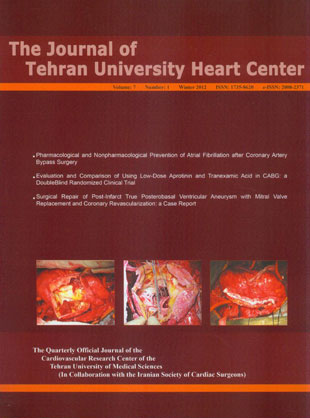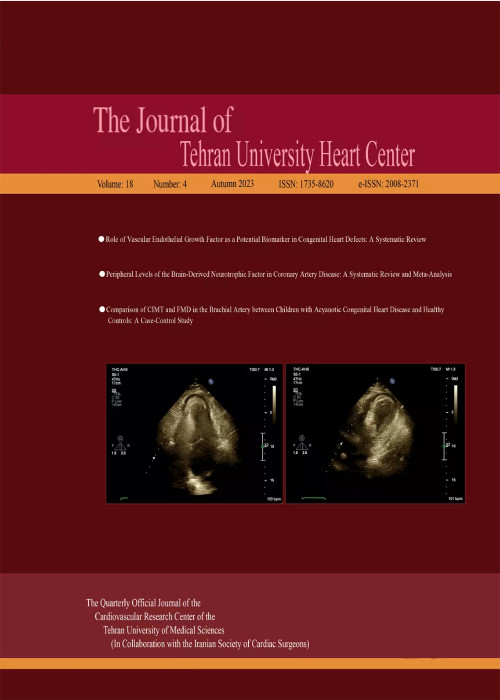فهرست مطالب

The Journal of Tehran University Heart Center
Volume:7 Issue: 1, Jan 2012
- 54 صفحه،
- تاریخ انتشار: 1391/01/25
- تعداد عناوین: 8
-
-
Page 2Atrial fibrillation (AF) is the most common complication of coronary artery bypass graft surgery (CABG). The reported incidence of AF after CABG varies from 20% to 40%. Postoperative AF (POAF) is associated with increased incidence of hemodynamic instability, thromboembolic events, longer hospital stays, and increased health care costs. A variety of pharmacological and nonpharmacological strategies have been employed to prevent AF after CABG. Preoperative and postoperative beta blockers are recommended in all cardiac surgery patients as the first-line medication to prevent POAF. Sotalol and amiodarone are also effective and can be regarded as appropriate alternatives in high-risk patients. Corticosteroids and biatrial pacing may be considered in selected CABG patients but are associated with risk. Magnesium supplementation should be considered in patients with hypomagnesemia. There are no definitive data to support the treatment with nonsteroidal anti-inflammatory drugs, angiotensin-converting enzyme inhibitors, angiotensin receptor blockers, procainamide, and propafenone, or anterior fat pad preservation to reduce POAF.
-
Page 10BackgroundDifferences in the quantity and distribution of coronary veins between patients with ischemic and non-ischemic cardiomyopathy might affect the potential for the left ventricular (LV) lead targeting in patients undergoing cardiac resynchronization therapy (CRT). In the current study, we assessed and compared the suitability of the coronary venous system for the LV lead placement in ischemic and dilated cardiomyopathy.MethodsThis single-centre study, performed at our hospital, retrospectively studied 173 patients with the New York Heart Association class III or IV who underwent CRT. The study population was comprised of 74 patients with an ischemic underlying etiology and 99 patients with a non-ischemic etiology. The distribution of the veins as well as the final lead positions was recorded.ResultsThere was no significant difference between the two groups in terms of the position of the available suitable vein with the exception of the posterior position, where the ischemic group had slightly more suitable veins than did the dilated group (48.4% versus 32.1%, p value = 0.049). There was also no significant difference with respect to the final vein, through which the LV lead was inserted. Comparative analysis showed that the patients with previous coronary artery bypass grafting surgery (CABG) had significantly fewer suitable veins in the posterolateral position than did the non-CABG group (16.3% versus 38.7%, p value = 0.029). There was, however, no significant difference between the two subgroups regarding the final vein position in which the leads were inserted.ConclusionThe final coronary vein position suitable and selected for the LV lead insertion was not different between the cases with cardiomyopathy with different etiologies, and nor was it different between the ischemic cases with and without a history of CABG. Patients with a history of procedures around the coronary vessel may have an intact or recovered venous system and may, therefore, benefit from transvenous LV lead placement for CRT.
-
Page 15BackgroundCardiovascular operations are associated with an inherent bleeding tendency that sometimes leads to severe bleeding and transfusion requirement. Pharmacological intervention to minimize post-bypass bleeding and blood product transfusions has received increasing attention from both medical and economic viewpoints.MethodsThis double-blind, randomized, placebo-controlled clinical trial recruited three groups of patients (each group consisting of 50 patients) undergoing on-pump coronary artery bypass graft surgery (CABG) and blindly randomized them to receive either low aprotinin, tranexamic acid, or placebo. The results were, subsequently, evaluated and compared between the groups. All the patients were operated on by one surgeon and the same surgery team.ResultsThe following variables were similar between the groups, and there was no statistically significant difference between the groups in terms of these variables: age (p value = 0.308), sex (p value = 0.973), hyperlipidemia (p value = 0.720), hypertension (p value = 0.786), smoking (p value = 0.72), and diabetes (p value = 0.960). The amounts of drainage from chest tubes were less in the aprotinin and tranexamic acid groups than the amount in the placebo group; the difference was statistically important (p value < 0.001). There was no statistically significant difference with respect to need for reoperation for bleeding between the three groups (p value = 0.998). Complications following surgery in the three groups were statistically the same and not significantly different. All the complications (myocardial infarction, pericardial effusion, neurological complication and renal complication) had a good course, and all the patients were discharged from the hospital uneventfully. There was no mortality in any group.ConclusionsLow-dose aprotinin and tranexamic acid can significantly reduce blood loss and transfusion requirement in CABG without importantly increasing mortality and morbidity.
-
Page 19BackgroundThe pulsatility index (PI) shows continuous blood flow to the end organs and is a significant factor believed to decrease in aortic coarctation. Correction of this factor is of great importance in the treatment of stenotic lesions of the aorta. However, there are minimal data regarding the trend of changes in the PI after stent implantation. Furthermore, the association between the PI and other echocardiographic indices in patients undergoing stent implantation is unclear. This study was designed to evaluate changes in the PI following stenting and its correlation with other echocardiographic indices.MethodsTwenty-three patients with a diagnosis of aortic coarctation consecutively underwent two-dimensional and Doppler echocardiographic imaging modalities twice (before and after stenting). The patients were divided into two groups based on the percentage of increase in the PI after stenting (< 50% or ≥ 50%). The relation between the post-stenting PI and the baseline echocardiographic indices was assessed.ResultsThe PI was increased from 0.89 (SD = 0.30) to 1.75 (SD = 0.51) after stenting (p value < 0.001). Baseline diastolic/systolic velocity (D/S velocity) ratio of the abdominal aorta (p value = 0.013), mean velocity (p value = 0.033), and peak gradient of the descending aorta (p value = 0.033) were significantly higher in the patients with ≥ 50% increase in the PI after stenting.ConclusionOur findings showed that elevation in the PI after stenting was a predictable criterion in patients with aortic coarctation: it was predicted by some baseline clinical and echocardiographic indices. Baseline D/S ratio velocity of the abdominal aorta, mean velocity and peak gradient of the descending aorta, and baseline systolic blood pressure were the statistically significant indices to predict ≥ 50% increase in the PI in our patients.
-
Page 25BackgroundCardiac rehabilitation has been recognized as one of the most effective strategies for managing cardiovascular indices as well as controlling the cardiovascular risk profile, in particular after coronary artery bypass graft surgery (CABG). However, the effect of this program on right ventricular function following CABG is unclear. The aim of this study was to evaluate the impact of cardiac rehabilitation on the right ventricular (RV) function in a cohort of patients who underwent CABG.MethodsA total of 28 patients who underwent CABG and participated consecutively in an 8-week cardiac rehabilitation program at Tehran Heart Center were studied. The control group consisted of 39 patients who refused to attend cardiac rehabilitation and only received postoperative medical treatment after registration in the Cardiac Rehabilitation Clinic. Two-dimensional and Doppler echocardiography was performed to assess the RV function in both groups at the three time points of before surgery, at the end of surgery, and at the end of the rehabilitation program.ResultsSignificant increase of RV function parameters were observed in both rehabilitation group (RG) and control group (CG) at the end of the rehabilitation program compared with post-CABG evaluation in terms of tricuspid annular plane systolic execution (RG: 12.50 mm to 14.18 mm; CG: 13.41 mm to 14.56 mm), tricuspid annular peak systolic velocity (RG: 8.55 cm/s to 9.14 cm/s; CG: 9.03 cm/s to 9.26 cm/s), and tricuspid annular late diastolic velocity (RG: 8.93 cm/s to 9.39 cm/s; CG: 9.26 cm/s to 9.60 cm/s).The parameters of the RV function did improve in both groups, but this improvement was not associated with participation in the complete cardiac rehabilitation program.ConclusionThe RV function parameters gradually improved after CABG; this progress, however, was independent of the exercise-based cardiac rehabilitation program.
-
Page 30T-wave oversensing occurs when the counter starts giving dual beeps for every cardiac cycle instead of one. This usually happens when the monitoring lead displays a tall T wave, which is also sharp. R wave sensing algorithms of the devices do not sense T wave because the slow rate of the T wave is much less than that of the R wave. But the slow rate of T waves may change with time and also because of parameters like potassium levels and hyperglycemia. We present a 67-year-old female who underwent the implantation of cardiac resynchronization therapy (cardiac resynchronization and implantable cardioverter defibrilator [CRT-D]) because of severe left ventricular systolic dysfunction and ventricular dyssynchrony experienced recurrent inappropriate implantable cardioverter-defibrillator (ICD) shocks and CRT failure. Device analysis showed that the CRT failure was in consequence of T-wave oversensing due to hyperglycemia. Elimination of the T-wave oversensing after hyperglycemia control conferred good biventricular pacing and good response to CRT during a 6-month follow-up period.
-
Page 33Echocardiography is considered the primary diagnostic tool for congenital heart diseases. The pediatric echocardiography diagnostic errors, consisting of false positive or discrepant diagnoses, picked up within a 2.5-year period in our pediatric echocardiography laboratory are presented herein. In this case report, the factors contributing to the diagnostic errors are categorized as cognitive such as misidentification/misinterpretation of findings and distraction by other diagnoses; procedural or conditional such as incomplete examination of anatomy/physiology and poor imaging conditions; and finally communicational or informational such as lacking or misleading patient’s history and incorrect requisition. The quality of diagnostic pediatric echocardiography can be improved if the operator has sufficient knowledge about the normal growth and development of children, different types of congenital heart defects, and principles of ultrasound physics.


